Tay Ninh
For the blind, visually impaired, or those who prefer to listen rather than read – listen to this chapter on Soundcloud.
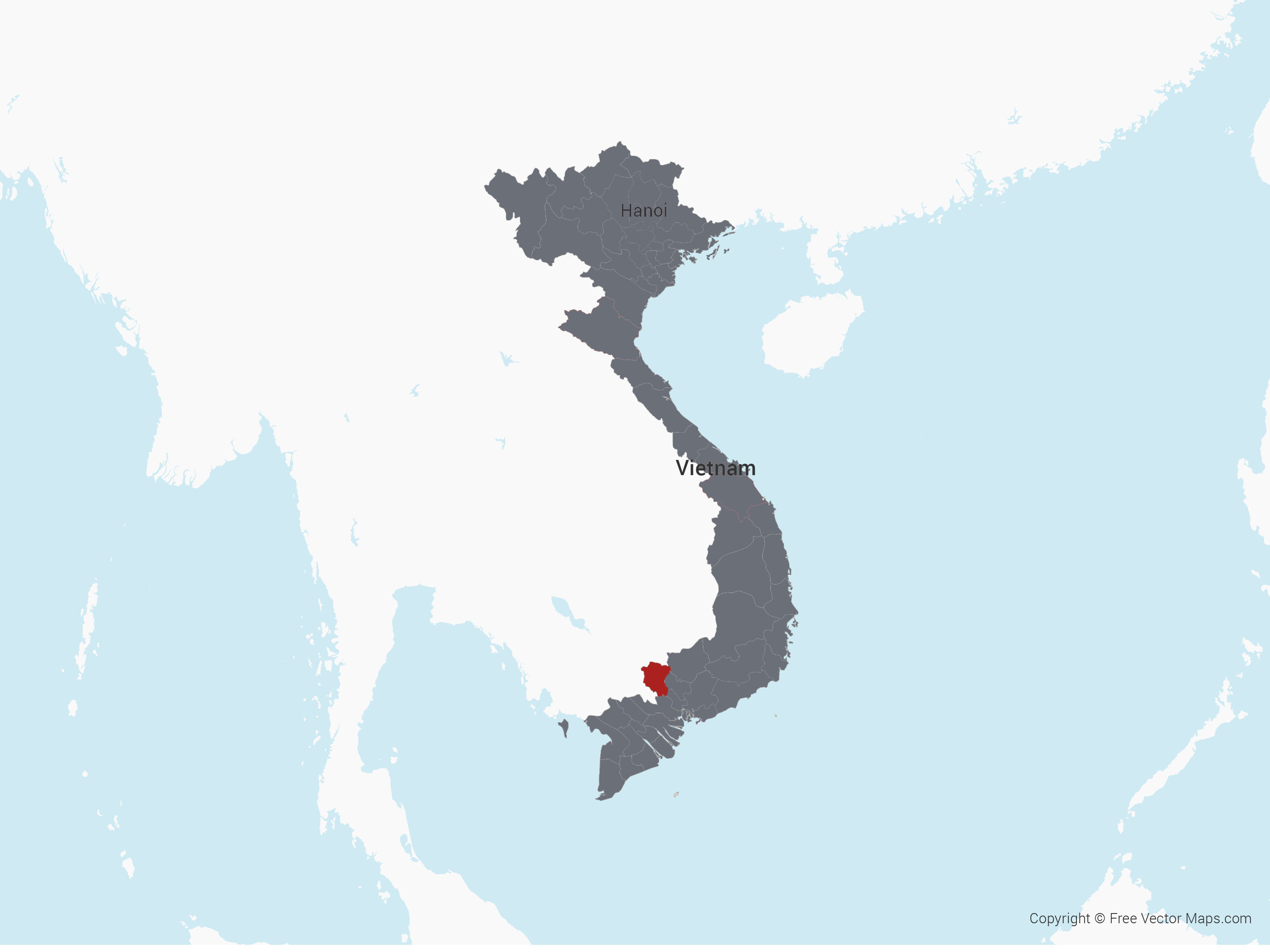
Sun creeps through the skeletons of what once was a thick brush of trees. The graveyard of the jungle from times past. The dirt road is a thick pool of mud, painting the barren tree trunks as motorbikes zoom by. It’s rainy season in Tay Ninh, a rural province in Southern Vietnam. The air is thick, heralding an incoming free fall of water from above. The motorcycle stops, causing one last tsunami of mud. Vo Thi Dep gently leans her Yamaha motorized scooter to the left before slowly dismounting. She kicks out the stand and parks it firmly in the mud. She exhales a deep breath before walking towards her destination. It’s just past 9 a.m. and it’s the first stop of many of the long day ahead.
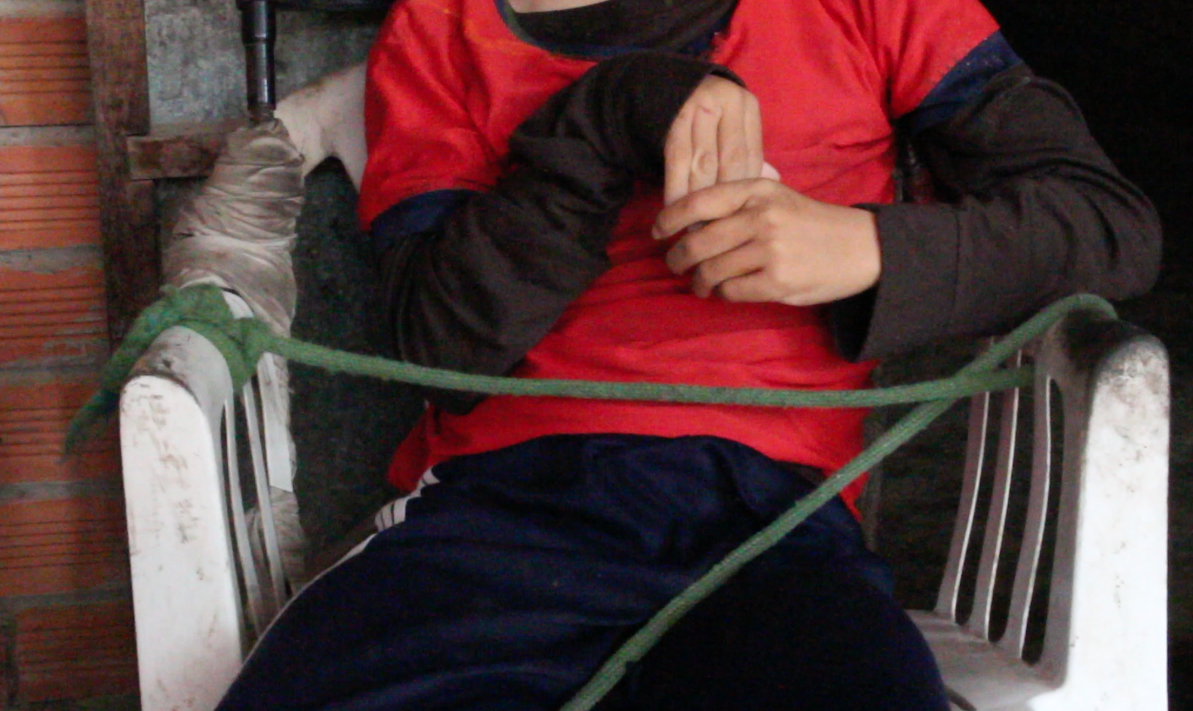
Nestled between two stalks of trees sits a brick shelter: four walls, a flat roof and a rectangular hole where a door belongs. A makeshift canopy made of tin and abandoned advertisements shelter the owners of the humble home. Beautiful faces of models with pale skin and big eyes smile down upon a young man and his aging mother. The man sits in a white plastic lawn chair that is held together by thin strips of dirt stained fabric. The chair that was designed for beach parties and camping adventures hasn’t moved in years – neither has its owner. A thick rope wraps around both the man and his seat, tethering the owner to his chair. He shakes and moans under the constraints. His head spins round and round as if surveying the area but not seeing a thing.
“Caring for him is very difficult,” says his mother, Thuong Thi Tran. “Our life is too hard.”
Thuong Thi Tran’s son, Nguyen Hong Quan, was born with a severe birth defect. He cannot speak or control his body. Thuong’s skin is weathered from years on her feet, her skin leathery from days spent under the beaming sun. Her hand reaches out to clean a stream of sweat from her son’s brow. Her long fingers are all bone, a skeleton wrapped in skin.
“When he was born, seeing such a situation, his father went away and left us behind. We don’t know where he is now,” says Thuong.
Each day Thuong ventures into the centre of the rural town on foot, her pockets full of pull-tab lottery tickets. She’s one of a number of women you’ll see wandering through bus stations, food stalls, and taxi stands, selling their tickets to anyone who’s looking for their luck to change. Thuong says her daily goal is to sell just 20 tickets. She’s not greedy; she just wants to make enough money to feed her son. If she sells all 20, she’ll take home 20,000 Vietnamese Dong or $1.10 Canadian.
“If only he could sit in a normal way,” laments Thuong.
“Every time I want to move, I have to get someone to pick him up because he is always twitching a lot.” When Thuong leaves to sell her lottery tickets her son is home alone. Each day he sits trapped between four walls, bound by rope to his seat. Thuong says she had recently fallen ill and was hospitalized overnight. She recalls a conversation with a doctor. “Oh my God, you are here, then where’s your son?” the doctor asked. “I tied him at home,” she replies. Without food or care, Thuong says she found her son dangling from his chair, convulsing, hanging by his restraints. “It made me scared to tears,” cries Thuong.


Nguyen Hong Quan sits outside his home in Tay Ninh strapped into his chair.
In a brief moment Nguyen tilts his sun-kissed face to look up at his mother. A steady stream of salvia makes its way from beneath his tongue down the nape of his neck. His eyes glimmer with what can only be described as recognition. The few seconds of clarity give way to a shudder and a shriek from deep within his body. He hiccups and his eyes roll upwards towards the collage of an awning. The models from the ads continue to smile in encouragement – the Westernized Vietnamese angels watching from above.
“He is in his world we cannot understand,” Thuong says with a deep and heavy sigh.
Thuong says she wants what’s best for her son but she can’t afford it. “I am looking for somewhere to send him.” She says that because her son isn’t an orphan and he doesn’t have the ability to take care of himself, institutions in the province have turned him away.
Unfortunately Thuong and Nguyen’s story isn’t unique.
In 2010, Vietnam introduced its first law to protect the rights of people with disabilities. Modeled after the United Nations Convention on the Rights of Persons with Disabilities, the law was put into effect on January 1, 2011. According to the law passed by Vietnam’s National Assembly, it’s meant to protect the disabled community from discrimination and stigma while providing them with equal access to education, work, and adequate health care. The government decided that each of its 58 provinces and five municipalities would implement the law to meet the particular needs of people with disabilities living in its area. Unfortunately, because of the economic disparity between the 63 regions in the country, the law has been criticized by many people working in the field.
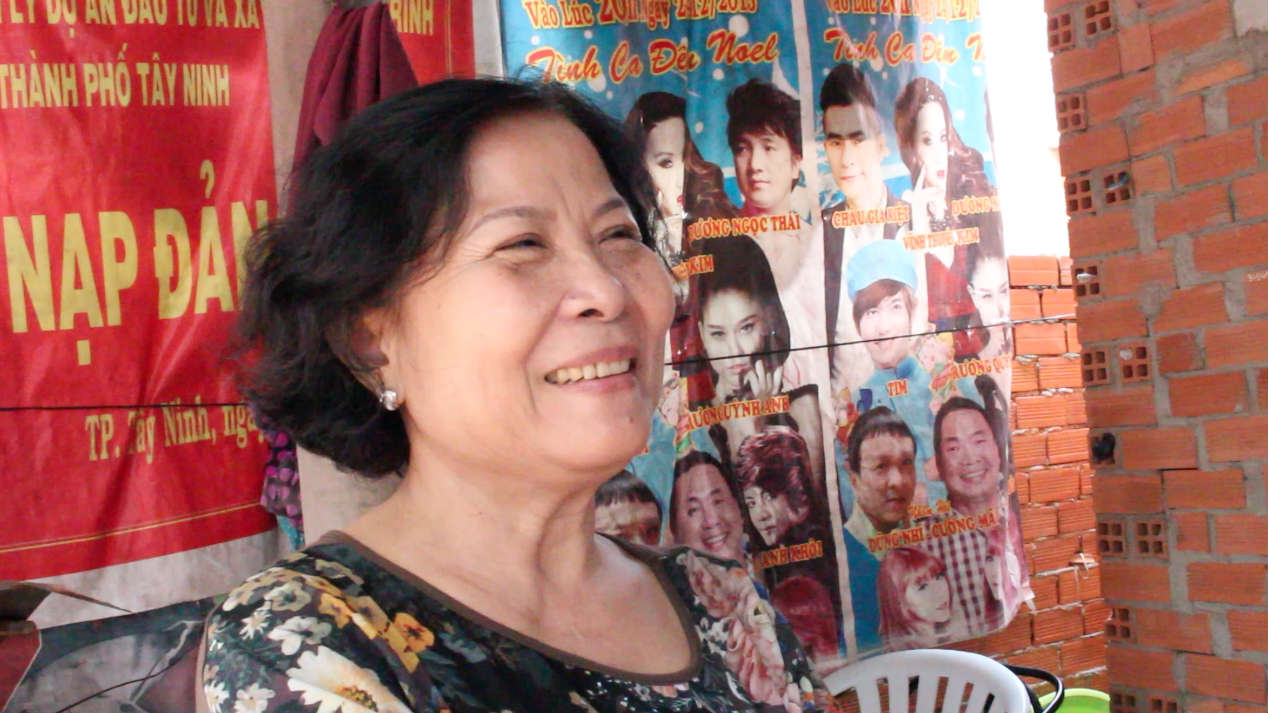
Vo Thi Dep sits outside the house of Thuong Thi Tran in Tay Ninh.
“We are so sorry we can’t help much more,” says Vo Thi Dep as she hands Thuong an envelope with a small sum of money inside.
Vo is the president of Tay Ninh’s chapter of the Vietnamese Association of Victims of Agent Orange/ Dioxin (VAVA). While she is not directly involved with implementing the legislation, she visits with the disabled community in Tay Ninh every day, working to improve their conditions and quality of life. Although the new law was first introduced nearly seven years ago, Vo says its effects are hard to see in a rural province like Tay Ninh.
According to Vo, her organization VAVA was initially formed with the mission to protect the Vietnamese survivors of Agent Orange.
The United States Army used Agent Orange during, what the Vietnamese call, the American War. With the home-turf advantage, the North Vietnamese and their allies the Viet Cong used the country’s lush jungles as a shield from their enemies. Burrowing underground, they created a death trap for the American soldiers that dared to enter. In an attempt to expose their enemy, the U.S. used this defoliant chemical to destroy the forest, making it easier for them to find and attack the Vietnamese guerrilla soldiers. Agent Orange successfully ruined the once vibrant jungle but it came with some deadly side-effects for the people on both sides of the war.
“There is some acceptance of the fact that there is a big problem because of the deformities and the health issues that are created,” says Dr. Wayne Dwernychuk. Dwernychuk is a retired environmental scientist and Agent Orange expert. In 1994, he and his British Colombia based company, Hatfield Consultants, were hired by the Vietnamese government to examine the levels of dioxin present in the soil around the country.
Tay Ninh neighbors the Bien Hoa American Army Base which Dwernychuk calls one of the three biggest hotspots in Vietnam for the dioxin present in Agent Orange, TCDD. According to his research, in the Bien Hoa region a TCDD concentration of 1.2 million parts per trillion (ppt) was found in the soil. To put this in perspective, he explains that the standard urban soil in the U.S. has an average concentration of 10 ppt. According to research compiled by the Aspen Institute, Tay Ninh was the fifth most heavily sprayed province in Vietnam with nearly 700,000 gallons of herbicides used in the area during the 1960s. Dwernychuk says that the U.S. government has spent over 80 million dollars to clean up another dioxin hotspot in the central province of Da Nang; Bien Hoa is next on their list, but it won’t be cheep. “Bien Hoa is a humongous base and it’s probably going to be five times that in terms of cost,” he says. He adds that with such a high concentration of dioxin present in the soil, and with the high volumes of rain in the region, Agent Orange has made its way into water and food supplies.
The U.S. Department of Veterans Affairs agrees that Agent Orange is toxic to human health, causing life-threatening illnesses from numerous types of cancers to Parkinson’s and spina bifida. “The U.S. has always maintained their position that there’s been no unequivocal scientific evidence that there is a direct relationship between dioxin contamination and birth defects,” says Dwernychuk. “Although you spend enough time in Vietnam and you go to the peace villages and see these children,” he says, his voice tapering off as he recounts his time working in Vietnam, “you kind of lean in that direction” he adds, siding with Vietnam’s implacable belief that Agent Orange is at fault for the high number of birth defects in dioxin hotspots across the country.
Dwernychuk says that there’s no concrete scientific evidence to back up either side and, at this point in history, there never will be. “It’s been so many years since the war,” he says with a sigh, “you can’t really go back and do a retrospective epidemiological study to determine what the problems are.” Although Dwernychuk can’t say conclusively that Agent Orange has caused birth defects, he believes that the U.S. still has a responsibility to the people of Vietnam.
“It’s time to just try to help to clean up Vietnam and help the people that that are being deformed,” he says, “even though they’re not perhaps, from the American perspective, influenced directly by Agent Orange.”
The following video is in Vietnamese with English subtitles. For the blind and visually impaired, listen to an English version on Soundcloud.
“We live in a toxic region,” says Vo back in Tay Ninh. Like many Vietnamese people, she believes that Agent Orange is to blame for the birth defects in her province. “It has now infected the fourth generation. The great-grandchildren,” she says, “there are still more than 4,000 children [in Tay Ninh] who are suffering.”
“They destroyed the health of the Vietnamese,” says Vo. “We want justice for the victims of Agent Orange.”
Vo stands in the shadows of the concrete slab of Thuong’s home surveying the slight structure. A big part of Vo’s and VAVA’s work is building houses for families impacted by the effects of Agent Orange. She says that each month they give a small allowance to these families, doing what they can to help support their needs.
Now that one of the slim white envelopes is resting safely in its owner’s pocket, it’s time for Vo to continue her rounds. She mounts her black scooter. The tarnished black paint is hot from sitting in the Vietnamese sun. As she revs the engine the thick mud dances beneath her tires. She zooms away leaving the man bound to his chair and his frail mother behind for another month. One well-traveled road of mud turns into another, then another, until the motorbike comes to a sudden stop and Vo dismounts her bike in front of a new small red brick home. Sitting in the doorframe is a middle-aged woman clinging to a young boy. Dressed in a dusty yellow sweatshirt with a matching pair of pants, the boy clutches a white cardboard box that once held Happi Koki cooking oil.
Peeking out above the box are two periwinkle eyes – big, round, and unavoidable. They are cloudy yet they twinkle in the sun as light reflecting off the Pacific. It’s like staring deeply into a foggy glass marble. He turns his box upside down and passes it to his mother, only to promptly steal it from her grasp. “He just sits and plays with his box every day,” says his mother, Ngo Van Vo.
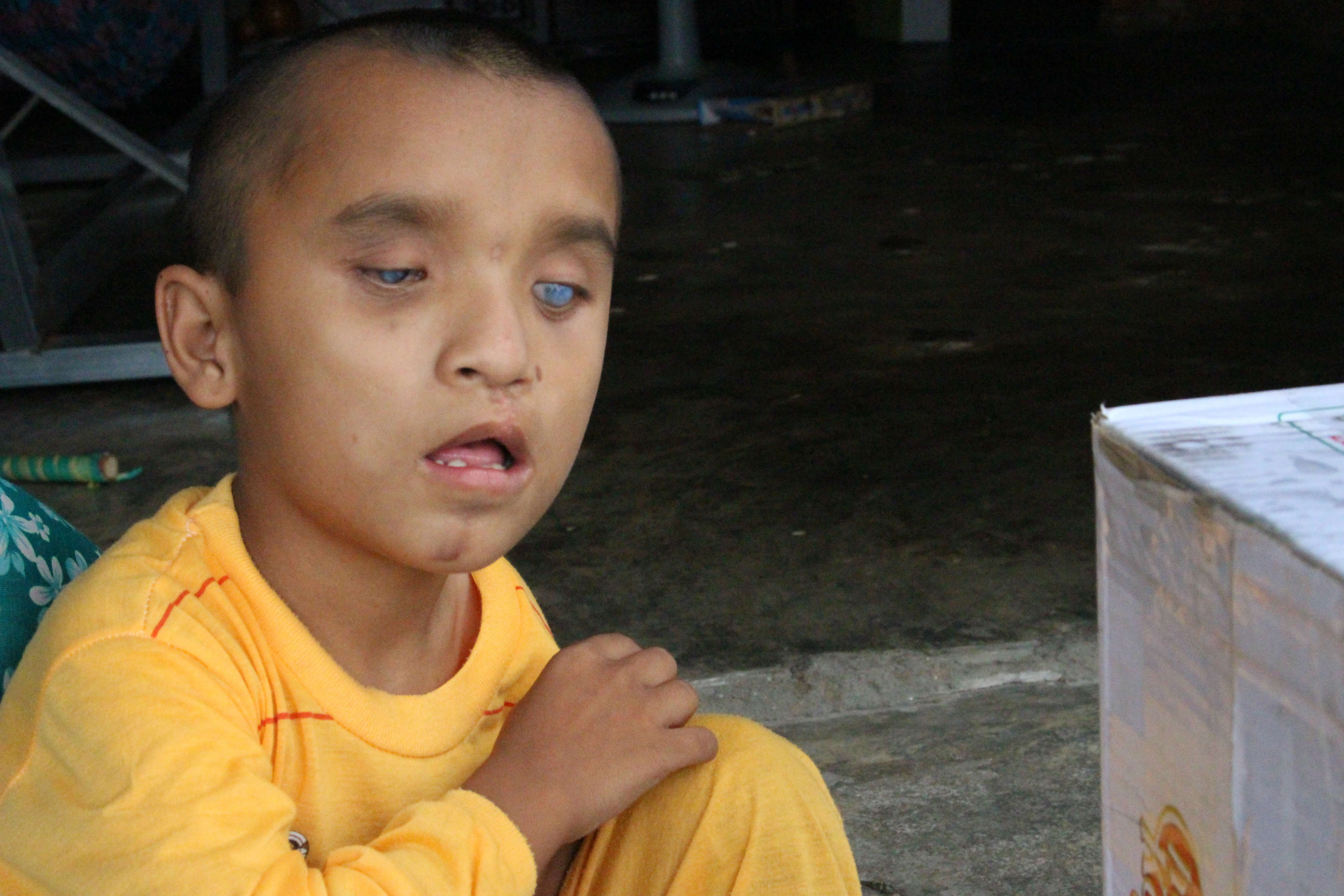
Ngo Van Vo’s son sits on the front stoop of their home.
Ngo’s son suffers from birth defects that she believes are related to Agent Orange. He has both the stature and the developmental capacity of a toddler, but Ngo says he’s 12 years old. “Now he can walk,” Ngo says with a smile, looking at her son as he takes a quick step towards his cardboard treasure and tumbles beside it. Along with his cognitive disability, her son is blind in both of his glassy blue eyes and has a cleft pallet. But for Ngo and her family every step, or stumble forward, is monumental.
The boy removes his hands from the box and plants them firmly on his mother’s face, pulling it closer to his. He speaks to her slowly, in a hushed and breathy manner. He’s not happy with the unexpected company. “He’s not very obedient,” Ngo laughs, blushing with embarrassment.
The boy tucks his head tightly between his legs, doing his best to conceal himself from the unwanted visitors, using his beloved box as a shield from the rest of the world. Ngo’s husband works far away and sends his paycheques home each month. Inside their small house sits a television set and a shiny gold karaoke machine – a favourite pastime of the Vietnamese. To afford these luxuries and take care of her son’s needs, Ngo says she also works during the day.
“He’s alone at home,” she sighs. “I just lock the door.”
The following video is in Vietnamese with English subtitles. For the blind and visually impaired, listen to an English version on Soundcloud.
Vo examines the scene with a watchful eye. She has another white envelope resting in her hands. She says that the boy’s learning disability means that he can’t attend school like other kids his age. So he sits, with his cardboard box nestled safely between his legs, locked in his house. Vo places the family’s allowance atop of the box. “This is a present,” she says, looking into the boy’s marbled blue eyes. “Give it to your mother.” Vo walks back to her scooter, and once again raises the kickstand– another monthly visit checked off her list.
Her bike turns towards the center of the small city. She passes red flags with glowing yellow stars as they flap rhythmically in the breeze. There’s billboard after billboard, not advertising snacks or the latest fashion trends but the message of the Socialist Republic of Vietnam. Ho Chi Minh, the father of communism in the country, or Uncle Ho, as he’s lovingly referred to, smiles down upon the commuters as they drive by. His eyes are always watching. It’s time for her final stop of the day. Her scooter takes a sharp turn into a gravel lot. Two long rectangular buildings line the wide piece of property.
Children spill out of the larger of the two structures because they’ve heard the sound of the motorbike’s engine. They’ve come to greet their guest and to get a much-needed break from their long day in the classroom. Vo says that this school is one of VAVA’s biggest projects in Tay Ninh. Her and her team built the entire school, brick by brick. After opening in 2013, the school teaches the students basic skills like handwriting and simple math. “At first, they knew nothing,” Vo adds. She surveys the crowd of nearly 20 students that now surround her. The children grow louder as they fight to have their voices heard above their classmates. “Now they communicate so much,” she laughs. Like the people at Vo’s first two stops of the day, the children at the school are all disabled. As she moves towards the schoolhouse her adoring fans trail behind, reluctant to return to their desks.
“These kids are still able to do everything by themselves,” she says with a smile, as the students drag their dirty sandal clad feet back into the shadowy school. “Kids who are in a serious state just stay at home.” Vo says that the other schools in Tay Ninh and the surrounding provinces don’t accept students with disabilities. Without the proper resources, teachers aren’t trained to educate the disabled community.
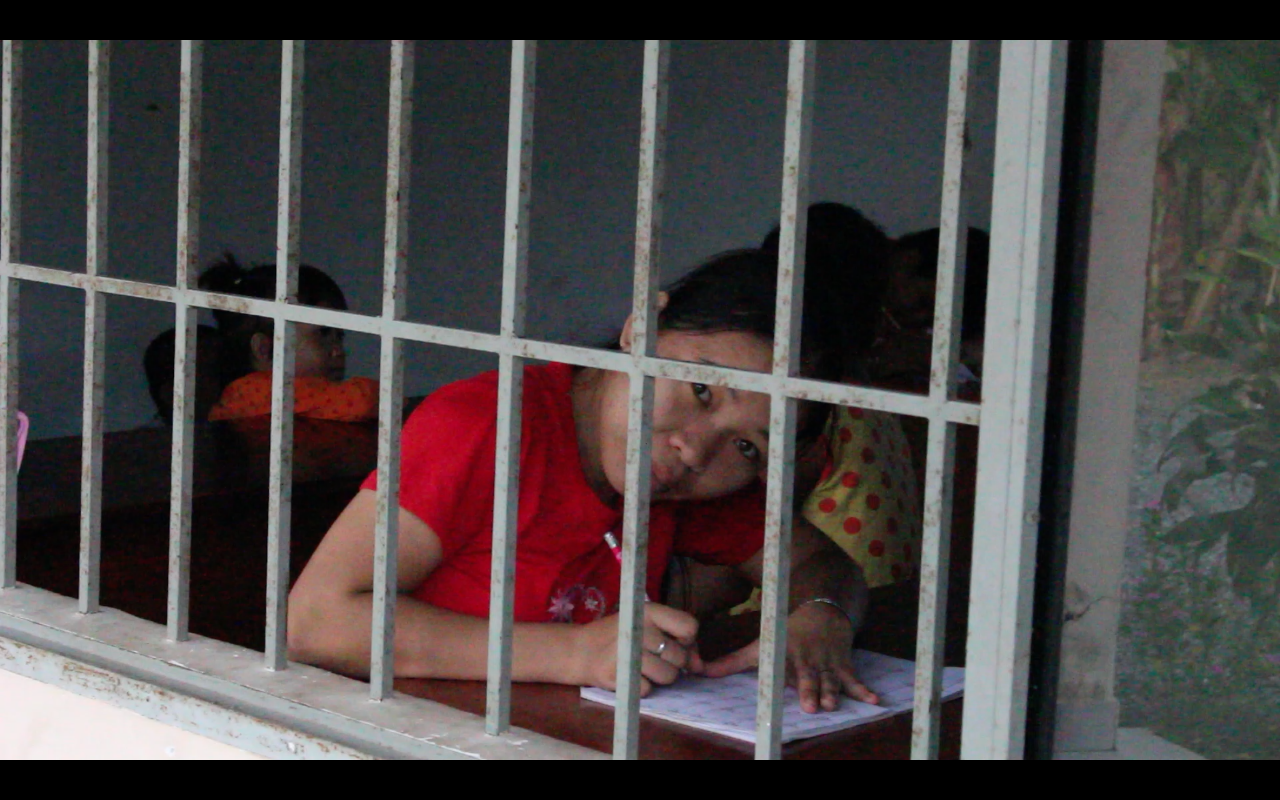
A student peers through the barred windows at the Centre for Feeding, Training and Educating the Victims of Agent Orange/ Dioxin in Tay Ninh.
The schoolhouse is made of concrete bricks. There are no doors, just large holes for people and light to enter. The windows are covered with thick steel bars. The desks that line the room begin to fill as the students return to their designated workspace. But not all of the classmates made the short walk to Vo’s scooter. In the back corner of the room lies a young man. His thin long legs are buckled at the knee with large knots of bone. His disability prevents him from moving and sitting at a desk. So instead he receives his lessons from his little spot on the floor. Some of the younger children skip towards the back of the room to tell him about their visitor. One girl even brings her workbook with her, proudly showing her quiet friend the work she’s been doing. The teacher sits at the front of the room behind a long wooden desk. Today she’s teaching her students the alphabet. White sheets of paper sit on top of each deck. For some the work comes easy. They laugh and cry with joy as they fill their page with large loopy letters made of led. For others, holding the pencil in their hands is proving to be difficult. A boy forcefully pushes the blank page off his desk and watches it slowly float to the ground. His hands are badly disfigured which is another side-effect that people in the area credit to Agent Orange. It’s not your average classroom. Some of the students rush around the room, full of energy and life. Others sit motionless in their seats, seemly ignorant to the happenings around them.
The following video is in Vietnamese with English subtitles. For the blind and visually impaired, listen to an English version on Soundcloud.
“They range from three to 30,” says Vo. Despite the large age-gap, all the students learn the same material. Vo explains that the school runs seven days a week, providing meals to the students and even room and board for those whose families live far away.
“It’s a basic function that they have a right to as human beings,” says Vo.
This school is the first step towards independence for these students. Without an education, Vo explains, “they are the burden of society.” Throughout Vietnam, especially in rural areas like Tay Ninh, there is a deep stigma towards persons with disabilities. In their society, many people view the disabled community as weak and incapable. They are frequently denied work and education simply because of their medical records.
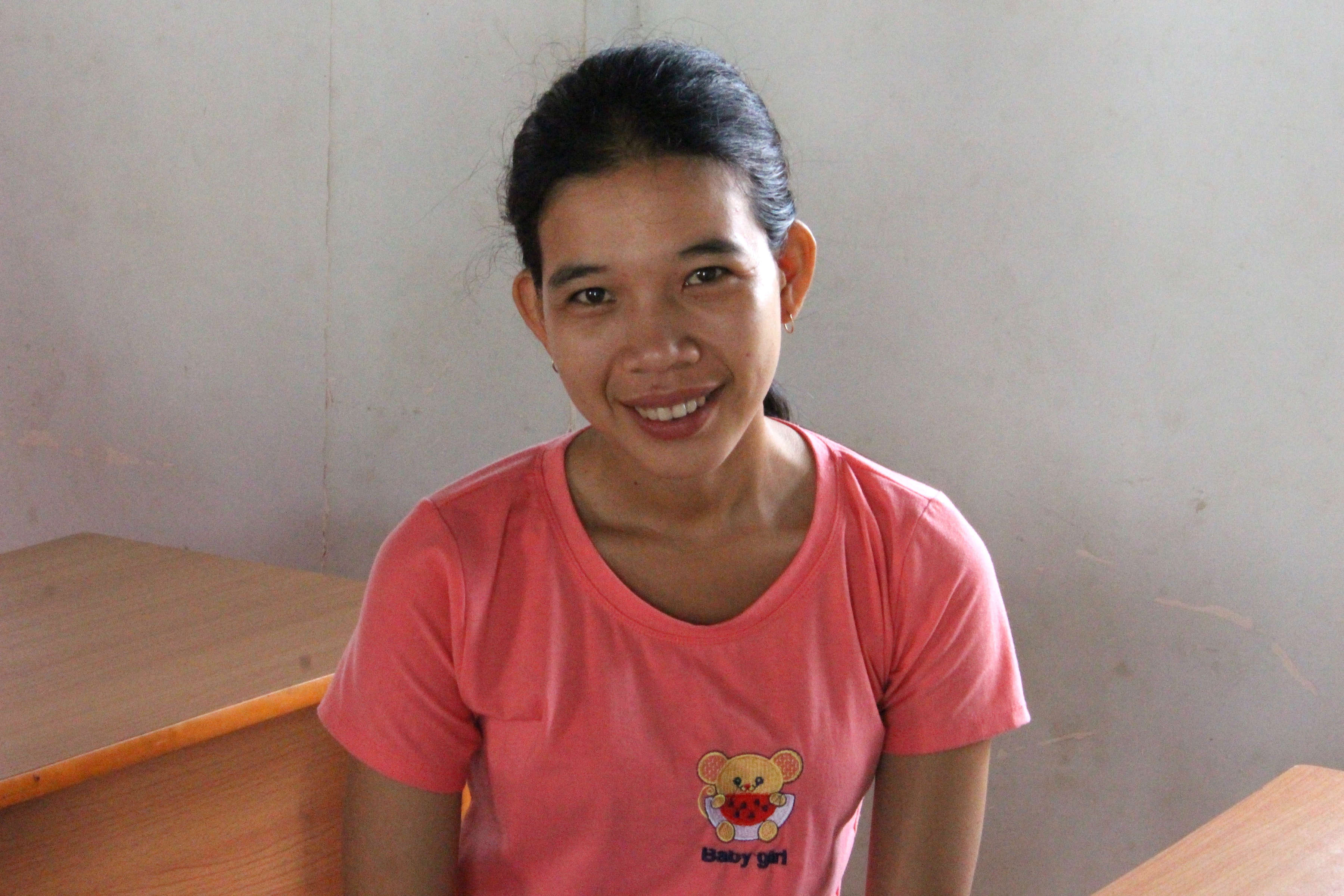
A student at the Centre for Training, Feeding and Educating the Victims of Agent Orange/ Dioxin in Tay Ninh smiles for the camera.
“We all look at the same sky,” Vo exclaims as she proudly examines the bustling classroom. “They can do the same things.”
The students are growing more restless. One young woman, who appears to be in her late teens, begins to belt out a famous Vietnamese tune. Though she’s off key, her audience doesn’t seem to mind as they huddle around and join in chorus. It’s nearly lunchtime which is Vo’s cue to return to her office and continue her work in solitude. She walks back towards her bike while admiring the school she built and the family that sits within it.
“You want to bring them a better life,” Vo says with a nod and a grin.
The hot sun is hiding behind a thick pair of grey clouds. The air grows thicker around her. Rain is due to fall from the sky at any minute. With that, Vo quickly mounts her scooter. The black paint is no longer hot to the touch. Tanned faces hang out of the school’s open doors. Their song grows louder and louder as more children join the choir. Their serenading is drowned by the sound of a singular engine followed by tires rolling against the gravel lot.